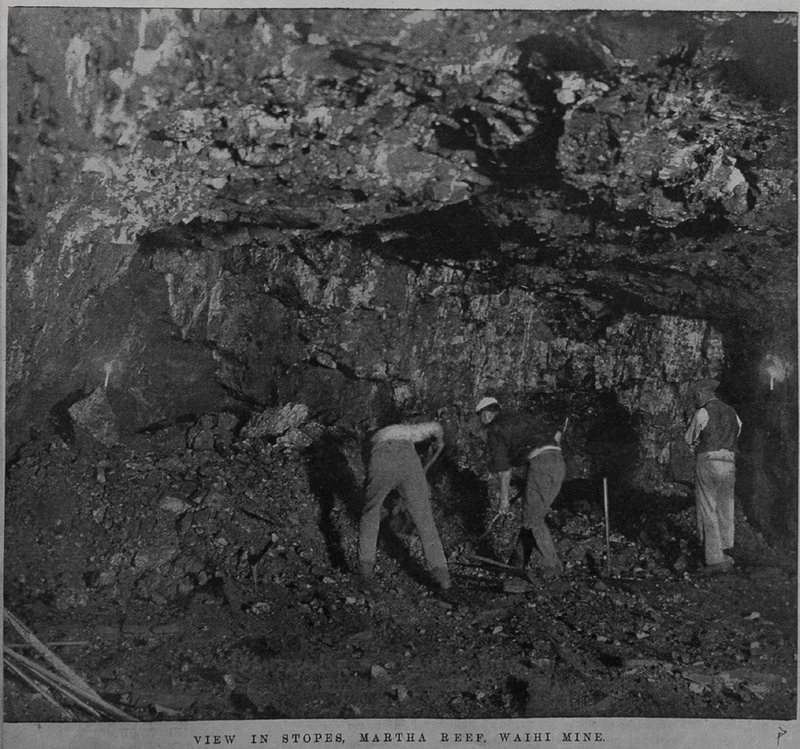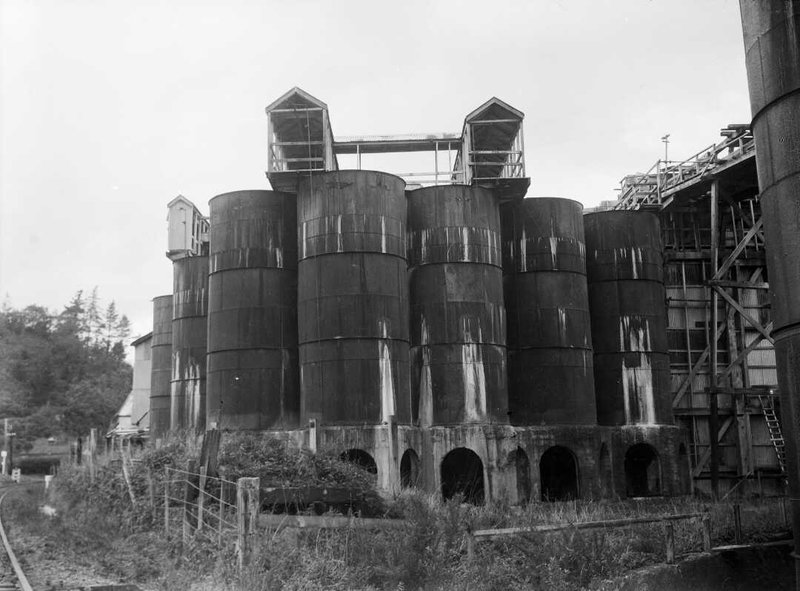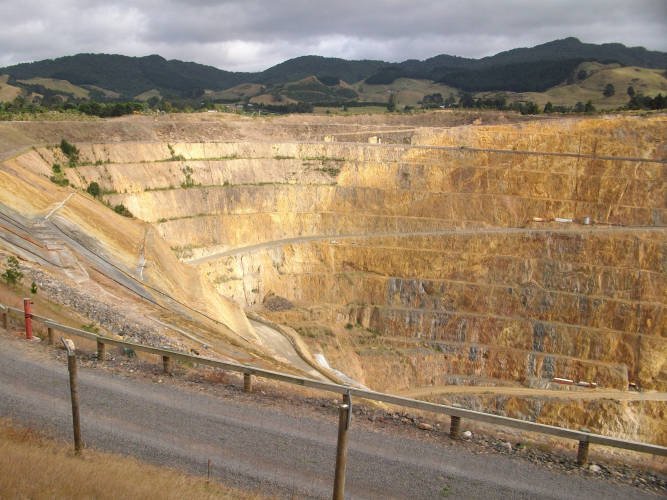The Martha Hill Mine at Waihī, is New Zealand’s richest gold mine. Between 1879 and its closure in 1952 it produced 141,747 kilograms of gold and 311,845 kilograms of silver. The mine reopened as an open pit mine in 1987.
Discovery
The Martha reef was discovered in 1878 by Robert Lee and John McCrombie. As the gold was in hard rock and expensive to mine, they found the ore was not payable, and left their claim for prospecting at Te Aroha.
In 1879 William Nicholl and Associates took over the claim, formed the Martha Extended Gold Mining Company of Auckland, and erected a 15-head stamper battery to crush the extracted ore.
The Waihi Gold Mining Company of London, promoted by Auckland businessman Thomas Russell, purchased the mine in 1891 and set about trials of new equipment to improve the extraction of gold and silver.
The mining process
In 1889, the Crown Battery at Karangahake was the world’s first to extract gold using the newly developed Cassel MacArthur-Forrest cyanide process. Much more efficient than extracting gold by mercury amalgam, the cyanide process made mining of gold from low-grade ore economically viable.
The New Zealand Government acquired the patent in 1897, allowing companies to use the cyanide process for a small royalty.
The Waihi Gold Mining Company adopted the cyanide process in 1894. In 1897 the Company expanded their operations with a new stamper battery and cyanide tanks at Waikino, known as the Victoria Battery.

Auckland Libraries Heritage Collections AWNS-18990609-2-2. Taken from the supplement to the Auckland Weekly News 09 June 1899 p2

Waikino battery, Waikato. Photographer unknown: Gold mining in the Waihi district. Ref: 1/4-015341-F. Alexander Turnbull Library, Wellington, New Zealand. /records/22748357
Waihi School of Mines
In 1897 the Waihi School of Mines was established to train workers in the technical skills required for the mining industry.
The Government offered a £1 for £1 subsidy on locally raised funds and the Auckland Education Board gave a quarter acre section. President of the school was Thomas Gilmour, Manager of the Waihi Gold Mining Company and later Mayor of Waihī. Students studied towards manager’s certificates for mine and battery management, bullion assayers and engine driving. Subjects taught included surveying, ventilation, pumping, winding, chemistry, assaying, mechanical drawing, electricity and magnetism, mechanics and hydraulics.
Increasing production
The Waihi Gold Mining Company expanded its operations through the early part of the twentieth century. The Martha mine expanded to seven shafts and fifteen levels of workings down to a depth of 600 metres. By 1907 the Company employed over 1,500 staff.
With increased production, the Company required more power to drive the stamper batteries. Searching for a site for a hydro-electric power station, the Company settled on the Horahora rapids on the Waikato River. With Government approval given in 1910, construction commenced and the Horahora Hydroelectric Power Station was commissioned in 1914. Electricity was delivered to Waihī and Waikino by 80 km of 11,000 volt 3 phase overhead power lines.
The Waihī gold mine was the largest industrial user of energy in New Zealand until the 1920s.
Strike!
In 1912 Waihī was the scene of violent industrial dispute. Miners went on strike for six months in protest over the Waihi Goldmining Company’s recognition of a separate union for engine-drivers.
Closure
The Martha mine closed in 1952. After 70 years of mining, accessible loads had been worked out and much of the Company’s equipment needed replacement. With international gold prices low, the company could not justify further investment.
The mine had produced more than twice the gold and silver of all the other New Zealand goldfields put together.
Reopening as an opencast mine
With an increase in gold prices, Martha mine reopened as an opencast pit in 1988.
In June 2016 Newmont Mining, now called Newmont Waihi Gold Company sold its Waihī mining operations to Oceana Gold Ltd, the New Zealand branch of an international mining company with operations in many parts of the world.
In December 2018 permits were granted allowing Oceana Gold to tunnel under properties to the east of the opencast pit using access from the Favona mine. It is expected that this will extend the life of the mine for a further 10 years.

Auckland Libraries Heritage Collections 1385-0092. Creative Commons Licence: Attribution CC BY
Heritage recognition
IPENZ “Engineering to 1990” project
This item of New Zealand’s engineering heritage was recognised with a plaque as part of the IPENZ “Engineering to 1990” project which the Institution organised to help celebrate the country’s sesquicentenary in 1990.
The Martha Mine No 5 Pumphouse has been recognised by Heritage New Zealand as a Category 1 historic place (List no.134). Martha Mine No 5 Pumphouse: New Zealand Heritage List/Rarangi Korero information.
The Waihi Gold Mining Company Cyanide Tanks has been recognised by Heritage New Zealand as a Category 1 historic place (List no.135). Waihi Gold Mining Company Cyanide Tanks: New Zealand Heritage List/Rarangi Korero information.
Waihi Gold Dredging Plant and Tramway has been recognised by Heritage New Zealand as an historic area (List no. 7670):
Waihi Gold Dredging Plant and Tramway: New Zealand Heritage List/Rarangi Korero information.
More information
Further reading
The Martha Mine is currently operated by OceanaGold.
''Black Tuesday," Ministry for Culture and Heritage, updated 19-Sep-2014. nzhistory.govt.nz/politics/black-tuesday/the-1912-waihi-strike
J. B. McAra, Gold Mining at Waihi: 1878 -1952 (Waihī: Martha Press, 1988 Rev. ed.)
P. R. Moore and N. Ritchie, Coromandel gold: a guide to the historic goldfields of Coromandel Peninsula (Palmerston North: Dunmore Press, 1996)
O. J. Morgan, “Waihi School of Mines 1897-1948,” Ohinemuri Regional History Journal, 7 May 1967, ohinemuri.org.nz/journals/33-journal-7-may-1967/486-waihi-school-of-mines-1897-1948
R. C. J. Stone. “Russell, Thomas,” Dictionary of New Zealand Biography, first published in 1990. Te Ara - the Encyclopedia of New Zealand, teara.govt.nz/en/biographies/1r20/russell-thomas
Carl Walrond, "Gold and gold mining - Gold and the economy," Te Ara - the Encyclopedia of New Zealand, TeAra.govt.nz/en/gold-and-gold-mining/page-12
Related Engineering New Zealand Record entries
Horahora Hydroelectric Power Station
Access
The Gold Discovery Centre offer tours
Location
Martha Hill, Waihī
Entry by John La Roche
Page last updated 12 November 2021
